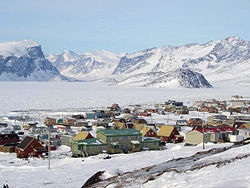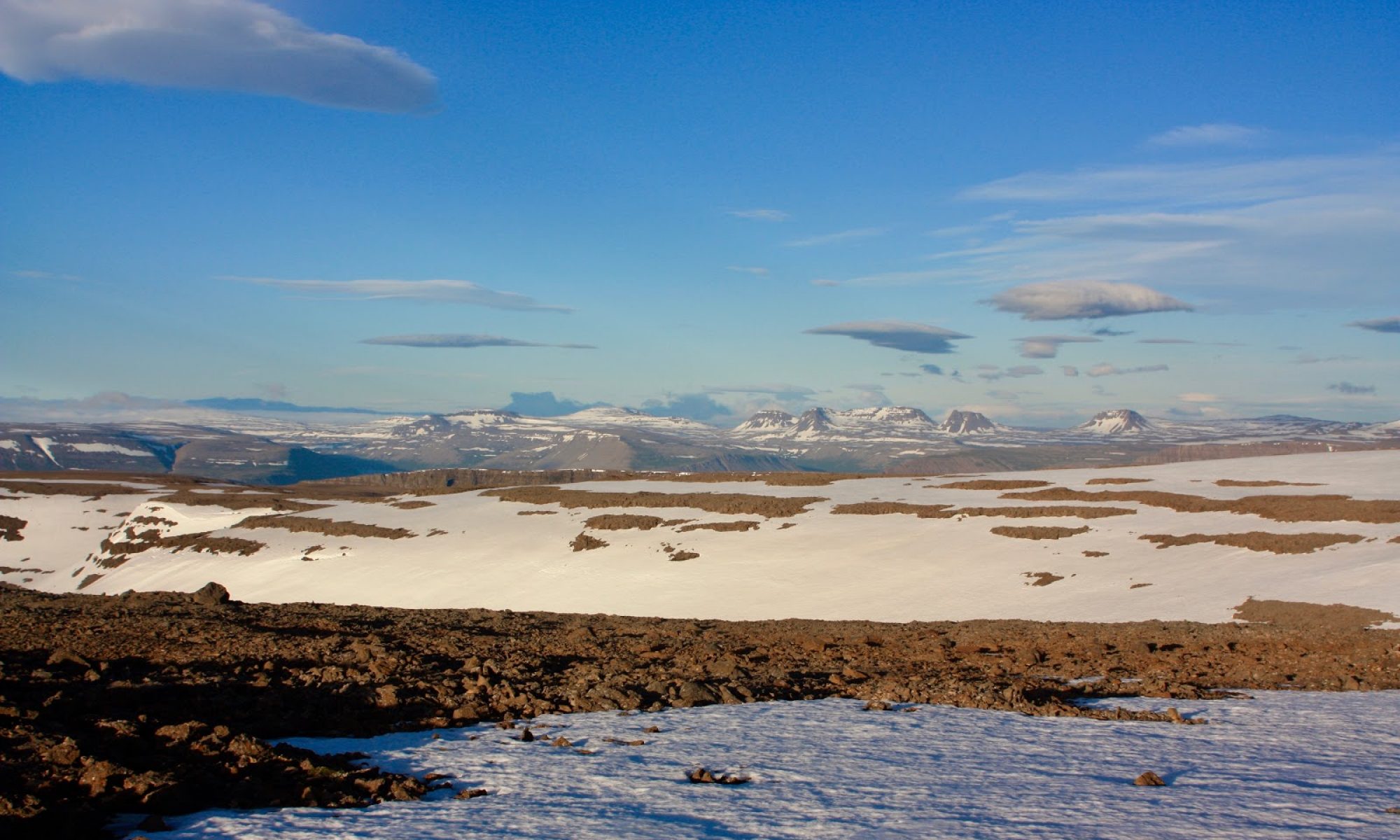
Despite the photo of tiny tundra plants, today’s entry is about music. But the photo is there for a reason, because music is grounded in a place. First, a question for music lovers: Where is some of the most exciting music coming from these days?
Where are the hotbeds of creativity, the towns where it seems that there is a musical renaissance happening, where the local fires of musical passion are burning bright? Austin? Atlanta? Seattle? Philly? Chicago? Toronto?
I’ll admit, it is a rhetorical question.
My guess is that you did not name any of these towns: Iqaluit, Pangnirtung, Salliut, Quaqtaq and Rankin Inlet. Maybe you have not heard of these places; not many Americans have. But maybe you have heard of Nunavut, the most sparsely-populated province of Canada.
It is a semi-autonomous province inhabited primarily by the Inuit people. It consists mostly of those hundreds of ragged and treeless islands that on a world map seem to fill up a whole lot of space between North America and the North Pole. Baffin Island, Victoria Island, Banks Island, Ellesmere Island, and many more.
So, what can be found in Nunavut? Polar bears and musk ox, sure. Narwhals even. But rock & roll? With a bari sax?
Here is a picture of Pangnirtung, courtesy of Wikipedia:

I don’t think you’ll find a nightclub here, but incredible music is coming out of the far north. Some of the most charismatic and soulful artists in Canada hail from villages in Nunavut, Northwest Territories, and the northernmost tip of Quebec.
Who are they? Here are a few of them: Elisapie, Josh Q and the Trade-offs, The Twin Flames, Riit, Beatrice Deer, The Jerry Cans. These names are increasingly well-known in Canada. Audiences in Europe and even Down Under are taking notice too.
Not many folks in the USA seem aware of this Northern rennaissance, yet—although Elisapie did make an appearance at an NPR “Tiny Desk” concert. So I’ll start with her, on a tune called Quanniuguma:
This music braids together many elements. Some elements are uniquely Inuit: The lyrics are in Iniktitut, the language of the Inuit, and there is the traditional Inuit technique known as throat singing. You’ll know it when you hear it.
But for Elisapie and for all of these artists, the musical language is a pretty complex blend of influences that come from all over. Jazz. Folk. Rock & Roll, of course. Country. Church music. French-Canadian and Celtic influences from Newfoundland and Quebec. Punk and Electronica.
Folks in Nunavut are as far away from everybody else as it is possible, on this earth, to get. Really. From Pangnirtung, the home village of several of these gifted musicians, it is about 300 kilometers by plane to Iqaliut, the only other town even remotely close. It is a much longer journey by boat, when the ice allows. The next closest settlement of any size is in Greenland, almost 700 kilometers away, across iceberg-filled ocean.
The other villages mentioned in this post—Salliut, Quaqtaq, Rankin Inlet—are on the mainland of North America, either on the northernmost tip of Quebec or on the other side of Hudson Bay. They are similar in size to Pangnirtung, and just as hard to get to.
Travel is by plane or boat or snow machine or dog sled… when the weather permits. It often doesn’t permit. And yet, when you hear the music that is coming out of Nunavut, you do not hear music that feels isolated from the world. You hear music that is connected.
For instance, in the song Iqaliut, by the Jerry Cans, you hear a touch of Reggae. In the music of The Twin Flames, you hear a definite Celtic influence. There are Inuit rappers. And in any song by Joshua Qaumariaq, you hear Mississippi Delta blues. (I’ll bet none of my readers ever expected “Arctic Soul” to be a genre.)
While you may hear a bit of Jamaica or Mississippi in some of these songs, there is no mistaking the unique character that comes from place. In all of them, you hear the North. You hear Inuktitut lyrics. Even if you don’t understand the words, you know they are about life in the North. Songs about hunting for seals. The Northern Lights. Songs about community, tradition, and connection. Or scouring the local landfill to find spare parts to fix a broken snow machine.
I don’t know how many of my readers have spent time in the arctic. I’ll tell you this: no ritual is more quintessentially arctic than “dump picking.” It is a good activity at any time, but especially when you need spare parts for the skidoo. (Be careful! Polar bears like the dump too.) Check out this delightful tune by The Twin Flames:
One of the common elements in music from Nunavut is the use of throat singing, a traditional form of musical expression among Inuit women. It is a sound that is entirely organic, made solely by the movement of air through a warm human body.
Think of it: In the Arctic, what materials were available to the Inuit for making instruments? Animal hides, of course, and so drums are a part of the culture. Beyond that, the human body is, itself, the only instrument readily available.
With its rhythmic use of breath, throat singing was used by mothers to lull babies to sleep. Women would also often engage in a good-natured game of throat singing with each other, to see which one would give in to laughter first. Is it a duet, or a contest? Both, sort of.
In Ataataga, Riit combines this Inuit tradition with the most modern of genres, electronica. Two women celebrating the ancient music of their heritage, of countless generations of women, and blending it with sounds made by synthesizers and soundboards.
If you like things a little more gritty, rest assured that the blues are alive and well in the North. In fact, a dose of the blues can pack the community center in Iqaliut—when the guy singing them happens to be Joshua Qaumariaq. This guy has a voice just made for the blues.
In case you are wondering, yes, he does sing the blues in Inuktitut too.
How did this all get started? Well, I wouldn’t know the answer to that, but surely someone in Iqaliut could tell you. My suspicion is that a significant part of the answer would involve a group of musicians with the awesomely-arctic name of The Jerry Cans.
The story of the name comes from an attempt by the drummer to use an assemblage of some jerry cans as a make-shift kit, in the absence of an actual drum set. Drums might be hard to come by in the Arctic, but there are always some empty jerry cans nearby. If you want to know what a jerry can is, here’s a picture:

This group, consisting of both Inuit and white musicians, has been a trailblazer for Indigenous musicians in Canada, and for those hailing from Nunavut in particular. Building on their success, and wanting to encourage others from the North, they built a studio and started Aakuluk Music, Nunavut’s only recording label. This is the mission statement on their website:
“The mission of Aakuluk Music is to help Nunavut musicians produce and promote their music. The label will help record, market, and distribute Inuktitut music nationally and internationally now, and for future generations of Inuit musicians. Aakuluk Music seeks to build hope through music and community, to encourage youth, and contribute to the preservation of the territory’s distinct culture.”
I have shared video from this band on my Facebook page more than once. As far as genre is concerned, they defy labels, but in an interview they have described their sound as “loud folk.” That comes about as close as anything else.
Something I love about the Jerry Cans is how they exemplify the belief that music plays an important role in creating and strengthening the bonds of community. They celebrate their culture, to be sure, but they do more than that; they offer songs of healing.
Villages in the far north have their share of problems, from suicide, to substance abuse, domestic violence, erosion of traditional language and culture, and the insecurity a changing climate brings to a hunting society that depends on sea ice.
Musicians are addressing these issues. Two excellent examples of healing songs are Swell, which addresses the epidemic of suicide among Inuit men, and Arnaluqaq, your soul carries the light, which addresses the problem of domestic violence against women.
Both of these beautiful songs take a deep source of suffering in the community, and transform it into… I don’t know, a kind of determination, maybe, to rise above grief and reclaim both dignity and resilience. To reclaim agency. To assert the value of each human being. Here is Swell:
I want to end with two songs that celebrate the beauty, resilience, value, and strength of Inuit women. One is sung by a woman, and addresses men. The other is sung by a man, and addresses women. The first is another song by Elisapie. The title is Arnaq, which means Woman.
Some spoken words at the beginning are translated: “I’m a woman. I give you life. I give you love. So you can give it in return. It becomes your mirror. Never forget where you are from. I’m a woman.”
I was not able to find a translation for the whole song. Some Inuit singers are not quick to offer English translations. This seems like a perfectly reasonable choice on their part. I’m not their primary audience. And after all, I could learn Inuktikut.
In searching for some information about this song, I came across the explanation that the song is an exhortation to men to value women and girls, to cherish them, and to “never forget where you came from.” This line, to me, does double-duty; it hearkens back to the womb, and, also, back to home. The village, and the land on which it sets.
Although I didn’t find a translation, I found an interview with Elisapie in which she says this: “I’m telling men they are the balance in women’s cause. In our history, women have always been close to their families, to care for them, while men had the duty to hunt and understand the territory… at the end of this role that was central to who they were, men lost a part of themselves. I want them to know that it’s possible to have both that strength, and the kindness…”
I love the scenes in this video that are of Inuit men, with their daughters, on the land.
The song I will end with is Arnaluqaq, by the Jerry Cans, which is introduced on the video as “A call to all the women in the Arctic who have been through — or are in — abusive relationships to remind them that they are beautiful.”
The repeated phrase arnalukaq piujuqpaalujutit means, roughly translated, girl, you are beautiful/good. It alternates with the phrase arnalukaq sanngijuujutit, which means girl, you are strong. The phrase arnalukaq puiguqtailigit means girl, don’t forget.
The introduction goes on to say, “This song is dedicated to all of our daughters to remind them that they are beautiful, and always will be – no matter what the circumstance. This song is ALSO dedicated to men of all ages who should be raised to respect their partners, to stand up to violence, abuse and harassment, and to never think any form of abuse or violence is acceptable.”
Throughout the song, we see a hand tending a qulliq, a seal-oil lamp. Source of heat and light for the home. “Your soul carries the light.”
This song really touches my heart every time I hear it.
I will be keeping my ears open for more great music from the far north.
